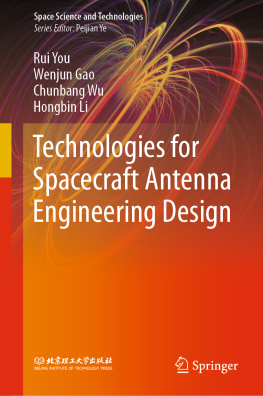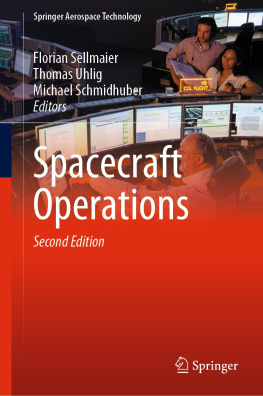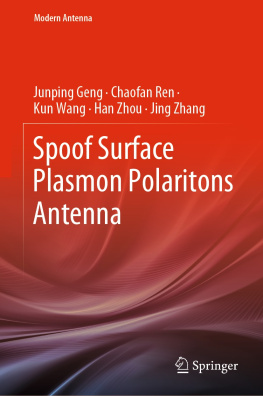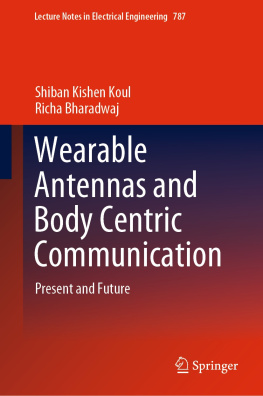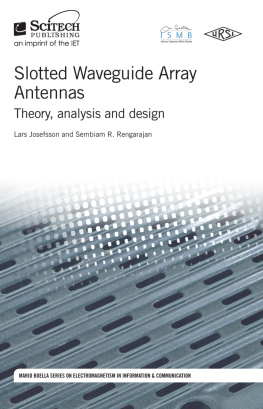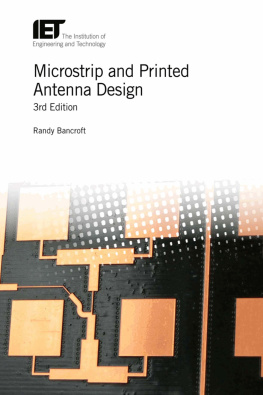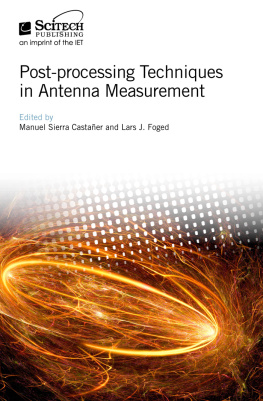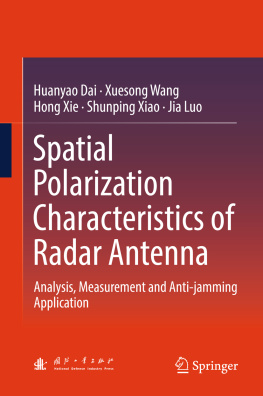Space Science and Technologies
Series Editor
Peijian Ye
China Academy of Space Technology, Beijing, China
Space Science and Technologies publishes a host of recent advances and achievements in the field quickly and informally. It covers a wide range of disciplines and specialties, with a focus on three main aspects: key theories, basic implementation methods, and practical engineering applications. It includes, but is not limited to, theoretical and applied overall system design, subsystem design, major space-vehicle supporting technologies, and the management of related engineering implementations.
Within the scopes of the series are monographs, professional books or graduate textbooks, edited volumes, and reference works purposely devoted to support education in related areas at the graduate and post-graduate levels.
More information about this series at http://www.springer.com/series/16385
Rui You , Wenjun Gao , Chunbang Wu and Hongbin Li
Technologies for Spacecraft Antenna Engineering Design
1st ed. 2021
Rui You
Institute of Spacecraft System Engineering, CAST, Beijing, China
Wenjun Gao
Institute of Spacecraft System Engineering, CAST, Beijing, China
Chunbang Wu
Institute of Space Radio Technology, CAST, Xian, China
Hongbin Li
Institute of Spacecraft System Engineering, CAST, Beijing, China
ISSN 2730-6410 e-ISSN 2730-6429
Space Science and Technologies
ISBN 978-981-15-5832-0 e-ISBN 978-981-15-5833-7
https://doi.org/10.1007/978-981-15-5833-7
Jointly published with Beijing Institute of Technology Press
The print edition is not for sale in China (Mainland). Customers from China (Mainland) please order the print book from: Beijing Institute of Technology Press.
Beijing Institute of Technology Press and Springer Nature Singapore Pte Ltd. 2021
This work is subject to copyright. All rights are reserved by the Publisher, whether the whole or part of the material is concerned, specifically the rights of translation, reprinting, reuse of illustrations, recitation, broadcasting, reproduction on microfilms or in any other physical way, and transmission or information storage and retrieval, electronic adaptation, computer software, or by similar or dissimilar methodology now known or hereafter developed.
The use of general descriptive names, registered names, trademarks, service marks, etc. in this publication does not imply, even in the absence of a specific statement, that such names are exempt from the relevant protective laws and regulations and therefore free for general use.
The publishers, the authors, and the editors are safe to assume that the advice and information in this book are believed to be true and accurate at the date of publication. Neither the publishers nor the authors or the editors give a warranty, express or implied, with respect to the material contained herein or for any errors or omissions that may have been made. The publishers remain neutral with regard to jurisdictional claims in published maps and institutional affiliations.
This Springer imprint is published by the registered company Springer Nature Singapore Pte Ltd.
The registered company address is: 152 Beach Road, #21-01/04 Gateway East, Singapore 189721, Singapore
Series Editors Preface
Chinas space technology and science research have earned a place in the world but have not been compiled into a series of systematic publications yet. In 2018, the series Space Science and Technology edited mainly by me and co-authored by the leading figures in Chinas space industry was published in China, when China Academy of Space Technology was celebrating the 50th anniversary of its founding. This collection contains 23 volumes in Chinese, only 10 of which have been selected, re-created and translated into English. In addition, each English volume has been re-created at the suggestion of the Springer, by deleting the contents similar to Springers existing publications and adding the contents that are internationally advanced and even leading, and bear both Chinese characteristics and worldwide universality. This series fully reflects the knowledge and engineering experience recently accumulated by Chinese scientists and engineers in space technology and science research.
As the Editor-in-Chief of this series, I always insist that this collection must be of high quality, either in Chinese version or English version. First, the contents of this series must be condensed and sublimated based on the combination of theory and practice, so as to provide both theoretical value and engineering guidance. Second, the relationships between past knowledge and state-of-the-art and between other peoples work and our own new findings should be properly balanced in the book contents to ensure the knowledge systematicness and continuity and to highlight new achievements and insights. Each volume intends to introduce the readers something new. Third, the English version should be customized for international exposure and play a solid supporting role for China to contribute to the worlds space field.
This collection consists of ten volumes, including Spacecraft Thermal Control Technologies, Spacecraft Power System Technologies, Spacecraft Electromagnetic Compatibility Technologies, Technologies for Spacecraft Antenna Engineering Design, Satellite Navigation Systems and Technologies, Satellite Remote Sensing Technologies, Spacecraft Autonomous Navigation Technologies Based on Multi-source Information Fusion, Technologies for Deep Space Exploration, Space Robotics and Manned Spacecraft Technologies.
Starting from the mission requirements of spacecraft, this volume, namely Technologies for Spacecraft Antenna Engineering Design, discusses the characteristics and design methods of various spacecraft antennas and describes the telemetry, track and command (TT&C), data transmission, navigation, inter-satellite link, payload, reliability, testing, the design cases of different antenna systems and the prospect of new technologies sequentially.
The publication of this series adds a new member to the international family of space technology and science publications and intends to play an important role in promoting academic exchanges and space business cooperation. It provides comprehensive, authentic and rich information for international space scientists and engineers, enterprises and institutions as well as government sectors to have a deeper understanding of Chinas space industry. Of course, I believe that this series will also be of great reference value to the researchers, engineers, graduate students and university students in the related fields.
Peijian Ye
Preface
Since 1957, in which the Soviet Union launched the first man-made satellite, the technologies related to spacecraft have got great success. The radio spectrum has extended from early VHF to L, S and C, X, Ku, Ka, W and even terahertz. Chinas space technology has also made achievements since 1970, in which Chinas first satellite DFH-1 was launched successfully into orbit. Up to the end of 2019, China has put more than 300 satellites in different types into orbit, including remote sensing satellites, communication satellites, navigation satellites, planetary exploration satellites, space-based observatory satellites and other satellites. The related antennas mainly include wire antennas, reflector antennas, multi-beam antennas, shaped reflector antennas, large deployed reflector antennas and phased array antennas. There are also advanced measurement facilities including plane scan near field, spherical scan near field, large compact range in CAST (China Academy of Space Technology). We would like to share our technologies and practical experience with worldwide peers to welcome the arrival of space economy.

